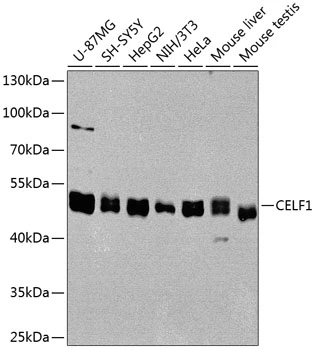CUGBP1 antibody [N1C1-2]
GTX114129
ApplicationsWestern Blot, ImmunoHistoChemistry, ImmunoHistoChemistry Paraffin
Product group Antibodies
TargetCELF1
Overview
- SupplierGeneTex
- Product NameCUGBP1 antibody [N1C1-2]
- Delivery Days Customer9
- Application Supplier NoteWB: 1:500-1:3000. IHC-P: 1:100-1:1000. *Optimal dilutions/concentrations should be determined by the researcher.Not tested in other applications.
- ApplicationsWestern Blot, ImmunoHistoChemistry, ImmunoHistoChemistry Paraffin
- CertificationResearch Use Only
- ClonalityPolyclonal
- Concentration0.24 mg/ml
- ConjugateUnconjugated
- Gene ID10658
- Target nameCELF1
- Target descriptionCUGBP Elav-like family member 1
- Target synonymsBRUNOL2, CUG-BP, CUGBP, CUGBP1, EDEN-BP, NAB50, NAPOR, hNab50, CUGBP Elav-like family member 1, 50 kDa nuclear polyadenylated RNA-binding protein, CUG RNA-binding protein, CUG triplet repeat RNA-binding protein 1, CUG-BP- and ETR-3-like factor 1, EDEN-BP homolog, RNA-binding protein BRUNOL-2, bruno-like 2, bruno-like protein 2, deadenylation factor CUG-BP, embryo deadenylation element binding protein, embryo deadenylation element-binding protein homolog, nuclear polyadenylated RNA-binding protein, 50-kD
- HostRabbit
- IsotypeIgG
- Protein IDQ92879
- Protein NameCUGBP Elav-like family member 1
- Scientific DescriptionMembers of the CELF/BRUNOL protein family contain two N-terminal RNA recognition motif (RRM) domains, one C-terminal RRM domain, and a divergent segment of 160-230 aa between the second and third RRM domains. Members of this protein family regulate pre-mRNA alternative splicing and may also be involved in mRNA editing, and translation. This gene may play a role in myotonic dystrophy type 1 (DM1) via interactions with the dystrophia myotonica-protein kinase (DMPK) gene. Alternative splicing results in multiple transcript variants encoding different isoforms. [provided by RefSeq]
- Storage Instruction-20°C or -80°C,2°C to 8°C
- UNSPSC12352203



![ICC/IF analysis of COS7 cells transiently transfected with CUGBP1 plasmid using GTX84692 CUGBP1 antibody [5B8].](https://www.genetex.com/upload/website/prouct_img/normal/GTX84692/GTX84692_1192_ICCIF_w_23061420_811.webp)
![WB analysis of HeLa cell lysate using GTX29549 CUGBP1 antibody [3B1].](https://www.genetex.com/upload/website/prouct_img/normal/GTX29549/GTX29549_1318_WB_w_23060722_225.webp)


